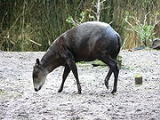
Yellow-backed Duiker
Encyclopedia
The Yellow-backed Duiker (Cephalophus silvicultor), is an antelope
found in central and western Africa
. They have the widest range of any duiker
in the genus Cephalophus.
Yellow-backed Duikers grow 3.8-4.8 feet in length and 30 inches (80 centimetres) high at the shoulder. They weigh around 130 pounds (80 kilogrammes). Their coat is dark brown to black, with a yellow stripe above their hindquarters. They live in dense and open rainforest
, where they eat seed
s, fruit
s, grasses, fungi, and foliage.
Antelope
Antelope is a term referring to many even-toed ungulate species indigenous to various regions in Africa and Eurasia. Antelopes comprise a miscellaneous group within the family Bovidae, encompassing those old-world species that are neither cattle, sheep, buffalo, bison, nor goats...
found in central and western Africa
Africa
Africa is the world's second largest and second most populous continent, after Asia. At about 30.2 million km² including adjacent islands, it covers 6% of the Earth's total surface area and 20.4% of the total land area...
. They have the widest range of any duiker
Duiker
A duiker is any of about 21 small to medium-sized antelope species from the subfamily Cephalophinae native to Sub-Saharan Africa.Duikers are shy and elusive creatures with a fondness for dense cover; most are forest dwellers and even the species living in more open areas are quick to disappear...
in the genus Cephalophus.
Yellow-backed Duikers grow 3.8-4.8 feet in length and 30 inches (80 centimetres) high at the shoulder. They weigh around 130 pounds (80 kilogrammes). Their coat is dark brown to black, with a yellow stripe above their hindquarters. They live in dense and open rainforest
Rainforest
Rainforests are forests characterized by high rainfall, with definitions based on a minimum normal annual rainfall of 1750-2000 mm...
, where they eat seed
Seed
A seed is a small embryonic plant enclosed in a covering called the seed coat, usually with some stored food. It is the product of the ripened ovule of gymnosperm and angiosperm plants which occurs after fertilization and some growth within the mother plant...
s, fruit
Fruit
In broad terms, a fruit is a structure of a plant that contains its seeds.The term has different meanings dependent on context. In non-technical usage, such as food preparation, fruit normally means the fleshy seed-associated structures of certain plants that are sweet and edible in the raw state,...
s, grasses, fungi, and foliage.

